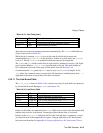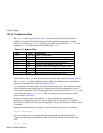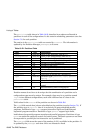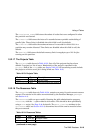
Listing of Tables
10.2.12 The Modules Table
The modules table shown in Table 10.17, contains descriptions of each hardware
module in a machine. The modules may be nodes, network components or storage
devices. It is created by rmsbuild. Entries are added and removed by rcontrol and
updated by rmsd and the Switch Network Manager, swmgr.
Table 10.17: Modules Table
Field Type Description
name char(16) name of the module
type char(16) type of the module, from the module types table
class char(16) class of module (node, network)
rack int ID of the rack that contains the module
unit int location of the module in the rack
psus int bitmap of the functioning power supply units
fans int bitmap of the functioning fans
estatus char(16) environmental status of the module
environment text description of the environmental status
Valid values for the type field are listed in the modules type table (see Section 10.2.13).
The psus and fans fields are bitmaps; their width is controlled by the corresponding
values in the module types table (see Section 10.2.13).
rmsd collects environmental data from the kernel on each node. The operational status
of the cooling fans and power supplies is logged along with the temperature status of
vital system components. This is used to generate an environment status, estatus, and
an environment string, environment. The environment status can take one of the
values shown in Table B.3.
If the environment status is recorded as ok, the environment string contains
temperature readings from the CPU, power supply unit and enclosure. If a node has
more than one instance of each type of temperature sensor, the maximum of their values
is recorded.
Temperature information is recorded as a list of attribute-value pairs, for example:
ambient=15 cpu=40 psu=20
If an error occurs, the environment string contains details of what has failed, for
example, the following string indicates that the CPU fan number 1 has failed on the
node.
cpu fan 1 failure
10-14 The RMS Database


















